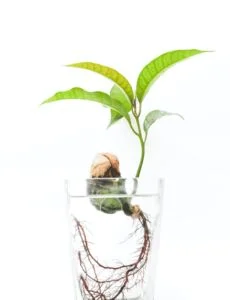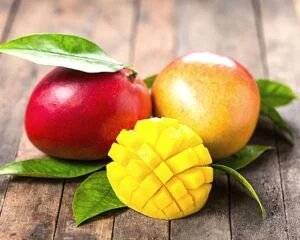How to Grow Mango
Learning how to grow mango is extremly rewarding, they are beautiful trees and produce amazingly delicious fruit it’s a win, win. You can find a variety of mango trees at plant nurseries or you can easily grow a mango from seed. Whatever route you choose we have you covered with the information you need to know.

How to Remove the Seed from the Mango Pit or Stone
Mango is a stone fruit although not nearly as stone-like as some of the more cold hardy stone fruits the tender seed which you want exposed to root and grow is inside a protective shell. Removing that shell accelerates germination / growth.
- Cut the fruit off of the seed
- Scrub with steel wool or scrape with butter knife to clean remaining flesh out of the way
- Find a place to start splitting the seed on the slender edge be careful not to damage the tender inner seed
- Finish prying open to remove the seed
Growing Mango From Seed

How to Plant a Mango Seed
Lay flat in nutrient rich soil keeping moist but well drained. Make sure to keep your new tree nice and warm with plenty of sun but don’t let it dry out.
Growing Conditions:
- Soil Type – Light Sandy Loam that drains well
- PH 5.5 to 7.5 – Neutral to slightly acidic
- Moisture Level – moist and well drained
- Temperature Range – Tropical Climates extended temp below 30 degrees Fahrenheit can severely damage or even kill a mango tree. USDA Hardiness Zones 9-11
- NPK – Mangoes like balanced NPK Levels
Mango Season and varieties
Mangos are available year round with a selection of varieties that have peak production covering nearly the entire year with the lowest production primarily spanning the months of October and Novenmber.
- Kent Mangos – peak season is December through early February.
- Haden – peak seson is late February into early May.
- Honey – A long peak season spanning late February through late July.
- Keitt – Peak production periods in march – April and the main peak season August – September.
- Tommy Atkins – Peak season from mid March through mid July.
- Francis – Peak season late April through the June
Mango Trees
Mango trees grow relatively quick and reach heights of 100 feet or more with a canopy of the 35 plus feet. The mango tree does however require a warm climate to much time around freezing can severly damage or kill mango trees.
How To Pick a Mango
Trying to figure out how to pick a mango from a mango tree can be intimidating the first time. But don’t worry even if you pick a little green you can still ripen the fruit up after it is off the tree.
How To Store Mangos
Mangos are fine stored at room temperature it also allows them to ripen quicker than under refridgeration.
How To Cut a Mango

How To Peel A Mango
You can peel a Mango with a regular vegetable peeler or I usually just cut broad strips and shave it off with a french knife or chefs knife laying skin side down on the cutting board and sliding through with a wiggling motion on the knife.
How To Slice a Mango
Cut parallel to the wide flat part of the seed by aligning the stem where the mango was picked from the tree with the hooked tip straight inline and pointed up, cut down roughly a finger width from the center on each side. Lay the flat side down and slice long ways.
How to Eat Mango
Mangos are delicious and very versatile. You can integrate them in or as your breakfast, lunch, snacks, dinners or dessert. This amazing fruit can be dried, purred, or used in salsa. Mangos are great in smoothies, or just eaten alone by itself. One of my favorite desserts is Thai sweet sticky rice with mangos. Try it once, and you will be addicted.
Mango Nutritional Info
Mango gives you Vitamin A
Mangoes contain provitamin A ( Beta-carotene), vitamin A is important for proper development in humans and animals. Humans are not able to biosynthesize vitamin A on their own however the provitamin A (Beta-carotene) can be converted to Vitamin A in the human body. A 3/4 cup serving of Mango 8% of the daily recommended Vitamin A.
Mango gives you Vitamin C
A 3/4 cup serving of Mango delivers 50% of the daily recommended Vitamin C.
Mango gives you Folate
3/4 cup of Mango provides 15% of the daily recommended value for folate which is vital for a healthy immune system.
Mango gives you Fiber
There are 2 grams of fiber in a 3/4 cup serving delivering 7% of the daily reccomended value for fiber.
Mango Calories
The USDA Daily Value Serving size of Mango is 3/4 cup which has approximately 70 calories at 17 grams total sugars. Each fruit is different, and the sugar it contains will vary a little. Still with this fruit being so low in calories, it is a satisfyingly sweet treat.
How To Tell if a Mango is Ripe
If you are at home, or at the grocery store and see all the beautiful mangos, your might be wondering, “how to tell if a mango is ripe?” If you have never picked out your own mangos, then you have come to right place. First, you have to decide when you want to eat the tropical fruit. Sometimes they are on sale because they will not be ready to eat for a few days, or they are ready for consumption at that moment. But how can you tell?
Whether your mango is ready or not comes down to feel and sometimes scent. Grab a mango in your dominant hand and hold it like you would a baseball. With your fingers, slightly, and I mean slightly squeeze the fruit with your thumb. You do not want to bruise the fruit, so use very slight pressure to test. Do not just apply pressure in one area, try the top (where the stem is) and try at least two other areas. If the fruit gives, and it is soft, you have 1-2 days to consume the fruit without it going overly ripe. If you squeeze the fruit, and it is hard, the fruit will not be ready for a couple days. If the mango is hard as a rock, you have a week or so.
Keeping mangos in the refrigerator will help them to last longer. So if you buy a couple or more and do not want them to ripen all at once, keep them in your fridge and take them out a day in advance. You can also tell by it’s scent. Although I would not judge on this alone, it could help give you clues to if it is ripe or not. If you can smell the sweet mango aroma, it is probably ripe and should be eaten. The fruit will also small if it is too ripe, so you cannot judge on this alone.
How To Ripen Mango
If I am in a hurry to eat this fruit, but it is too hard and not ripe yet, I will place it in a brown paper bag. This can be done with just about all fruits to help it ripen faster. This is because at the fruit matures it gives off carbon dioxide. The carbon dioxide will encompass and circulate around the fruit stimulating it to mature faster.
This is very easy, and can hasten the ripening by a day to half a week. Just place the fruit in a brown paper bag, and close the lid. I crumple the top to the mango and then set it on a warm area to help encourage the process. I place mine on top of the refrigerator because the compressor generates heat.
How to Tell if a Mango is Bad
Can You Eat Mango Skin?
Although it is okay to eat mango skin and probably will not hurt you, I do not think it is an experience you would enjoy. Mango skins are very tough, rubbery, and hard. They also have an extremely bitter taste to them. The “meat” or the yellowish orange goodness we consume is under the skin, and although the skin is edible and non-toxic, I would not advise it. As you peel the fruit, if a small sliver or area of the peeling remains, it will not hurt you to eat it, you will just know once you have chewed on it for a little bit that indeed you chewed on the rubbery skin.
Some fruits like apples have skins that are not only edible, but they contain a lot of nutrients of the fruit. Mango skins are not consumed, so there is no scientific studies on the nutrient value of mango skin. It does contain a lot of cellulose which is basically fiber, but other than that, there is not really any nutrient necessity to eat the mango skin. Since our bodies to not have the enzymes to break down cellulose, your body will not be able to break down the skin. This could cause an upset stomach or digestive problems, which is another reason I do not recommend eating mango skins. There are also better and safer ways to add fiber to your diet.
Mango Recipes
Dried Mango
Dried mangoes are slices, strips, or cubes of mango fruit, where all the juices are evaporated so they can be stored and eaten later. Drying fruits has been around for hundreds of years, and it is a way to preserve your fruits and fill up your pantry for the winter time. Or if you have a lot and want to preserve them. There are 3 options to dry your mangos.
The first in my opinion is the best. Use a food dehydrator which slowly dries out the fruit over a period of time. A food dehydrator is can be used to dry out many fruits, vegetables, and herbs at very low temperatures. Dehydrators comes with racks to place your mangos (or other foods) on, and a heater. You can control the temperature, and it is very easy on the foods being dehydrated.
Another option is to sun dry your mangos. It is the cheapest option although you have to keep an eye on your fruits. Being open outside runs the risk of dirt blowing on them, insects crawling on them, or birds eating them. Also the when sun-drying, you need the sun, so watch the weather. A major down side to this technique is it could take days to fully dry your mangos out.
The third option for dried mangos is to use your oven. Start by setting your oven to either 150 degrees, or or the lowest setting it will go, if does not go that low. Spread the mango pieces on parchment paper and place the pan in the oven. The down side using this option is that it doesn’t dry the fruit equally. Some parts of the slices are too dry and others not.
Once you have successfully dried your mangos, you can store them in airtight containers or freeze them. Once placed in your jar or airtight container, place in out of direct sunlight, humidity and heat. Done properly you can enjoy your dried mangos up to a year.
Frozen Mango
Cut up lay on sheet tray and freeze then bag up once frozen this way your mango chunks aren’t stuck together.
Mango Puree
Cut up mango into chunks with skin and seed removed. Puree in food processor or blender until smooth. For extra smooth puree push through a metal screen strainer with rubber spatula.
Mango Juice
Peel Mango, Remove the seed and cut into chunks. Blend until smooth and add distilled water to get the desired viscosity. Strain though a mesh strainer for a lighter no pulp juice.
Mango Jelly
Love mangos, then lets jam, and make some mango jam.
Ingredients
2 pounds of ripe mangos
1 1/2 cup od white sugar
3/4 cup water
3 saffron treats (optional)
Boil, or steam the mangoes whole, until they are soft. The them cool enough so you can work with them. Peel and remove inner seed. Use a blender and blend the mango pulp well.
Make a symple syrup by boiling the sugar and water in a large saucepan over high heat. Stir so you do not burn the pan. When mixture begins boiling, increase heat to medium-high. Continue boiling until fine, soft threads form, 270 degrees F (135 degrees C). Stir in the mango pulp, add the saffron threads, if desired, and boil until the mixture thickens, about 5 minutes.
Pour cooked jam into sterilized jars and seal according to canning directions.
Mango Salsa
This delicious mango salsa recipe is easy and fast. You need six basic ingredients to create this dish: Ripe mangos, bell peppers, red onions, jalapenos, cilantro and lime.
Use this mango salsa on fish tacos, alone with chips or just about any fresh, Mexican-themed dish. It’s sweet, spicy and absolutely delicious. You could also use it on salads or just eat it straight out of the bowl with a spoon. It is truly that good.
Fresh Mango Salsa
Total Time: 15 minutes
Recipe yields about 3 cups salsa.
Ingredients:
1 medium red bell pepper, chopped
½ cup chopped red onion
¼ cup packed fresh cilantro leaves, chopped
1 jalapeño, seeded and minced
1 large lime, juiced (about ¼ cup lime juice)
⅛ to ¼ teaspoon salt, to taste
Instructions:
In a serving bowl, combine the mango, bell pepper, onion, cilantro and jalapeño. Drizzle with one lime juice.
Stir the ingredients together. Season to taste with salt. For best flavor, let the salsa rest for at least 10 minutes.
Mango Sauce
This colorful dish goes amazing with pork, chicken, shrimp, tofu, or any other protein really. It’s mix of sweetness from the mangos, sour from limes, spice from chili sauce, and fish sauce saltiness flavors combined with beautiful aromatics and vibrant colors. Coconut milk adds a rich tropical flavor.
When preparing, use the ripest mango you can find. A ripe mango should give a little when you gently squeeze it with your thumb.
Ingredients
- 2 ripe mangos
- 3 cloves garlic, minced
- 1/4 cup thick coconut milk
- 2 tablespoons fish sauce
- 2 tablespoons Thai sweet chili sauce
- 2 tablespoons brown sugar
- 1 tablespoon lime juice
- 1/4 to 1/2 teaspoon dried crushed chili
- 1/4 teaspoon tumeric
Peel and chop the mangoes and put them in a food processor or blender.
Add garlic, coconut milk, fish sauce, sweet chili sauce, brown sugar, lime juice, chili, and turmeric to the blender.

